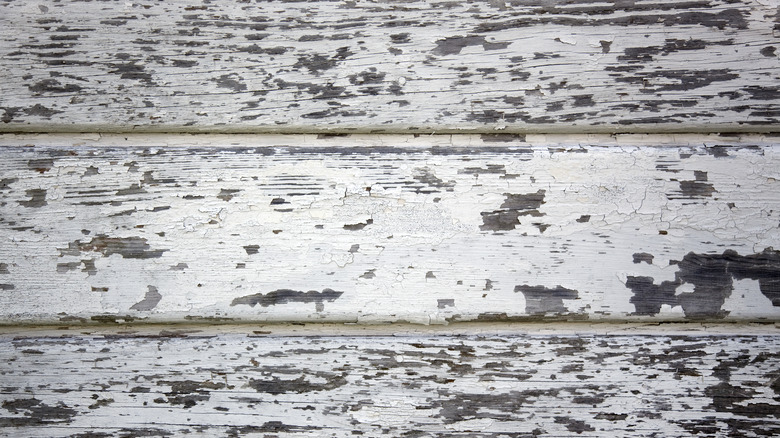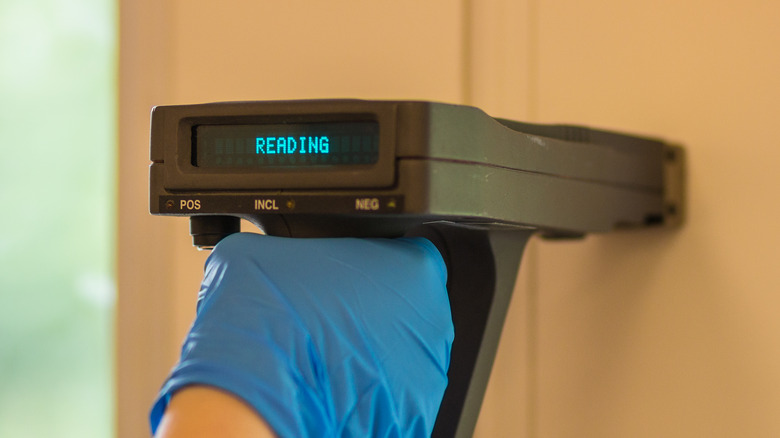How To Tell If Your Home Contains Lead-Based Paint
Humans have been using lead for thousands of years even though its toxic properties were known as far back as 2000 B.C., per The Center for Biological Diversity. Still, that didn't stop the Romans from using it with everything — in their cooking utensils, wine urns, aqueducts, and even makeup. It's easy to see why: Lead was seen as an easy metal to work with for a number of reasons, including its low melting point and impressive corrosion resistance.
While childhood lead poisoning was first suspected in 1892, the metal was not removed from household paints until 1978, per the Centers for Disease Control, and from gasoline in 1990, according to The Center for Biological Diversity. Unfortunately, as the Environmental Protection Agency (EPA) points out, this means that 87% of homes built in the United States before 1940 are likely to have some lead paint, as do 24% of houses built between 1960 and 1978, which is when it was eventually banned. Green Orchard Group further says this contamination is of particular concern in New York City because nearly 70% of the region's residences were built before 1960.
If you suspect that your home might still have lead paint, there are ways to confirm this so that you can take action.
Using lead paint home test kits
The quickest and most cost-efficient way to find out if your home has lead paint is to use a home test kit, which uses chemicals that change colors when lead is detected, per WebMD.
Although the EPA says home lead kits are readily available for purchase from hardware stores, it also warns consumers to take extra care if they want to use these kits to determine whether there is lead paint present in their home. As the Consumer Product Safety Commission points out, many of these kits deliver a high percentage of false negatives. During their evaluation of consumer test kits, the CPSC says that of 104 test results 56 were false negatives while two were false positives.
If you want to use a home test kit, Green Orchard Group says that three have been cleared by the EPA: 3M LeadCheck, D-Lead, and the State of Massachusetts Test Kit, which can only be obtained in Massachusetts. To use home kits yourself, Green Orchard Group recommends you test an area two or three times because replicating the same result diminishes the chances of a false negative.
Using XRF analysis
Another way to test for lead is to engage the services of an inspector who will use a portable X-ray fluorescence (XRF), which WebMD says can measure lead in paint without leaving any permanent marks. As with home test kits, using an XRF can give you quick results, but it isn't always able to provide conclusive ones.
Environmental health and safety consulting firm Cashins & Associates also points out that the device can only detect the presence of lead above a specific concentration, and that the method currently remains unsanctioned by the Occupational Safety & Health Administration because levels of lead it cannot detect can still be considered hazardous.
Still, Green Orchard Group says the technique has its supporters because it delivers fast, accurate results and because it leaves paintwork intact. However, an XRF machine needs to be used by a qualified lead inspector and cannot be used on "irregular or damaged surfaces," so it's not exactly an ideal test that will meet everyone's needs.
Sending samples to a lab for testing
A third way to test your home for lead paint is to conduct a risk assessment, in which WebMD says an inspector tracks down spots where paint has started deteriorating and then retrieves samples to test. The inspector will also collect paint from any surfaces which appear to have been mouthed or chewed by a child. During this time, dust samples can also be collected, with all the samples being sent to a lab for analysis.
Green Orchard Group says a more thorough risk assessment can also be conducted by removing paint chips of about four square inches in size from different parts of the house and then sending those to a lab for testing. However, because both risk assessments require testing only specific surfaces around your house, a negative report may also prove to be inconclusive. As such, WebMD says you may want to use several lead-testing methods at once to ensure you get the most accurate results possible.



